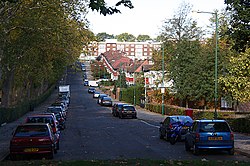Dollis Hill
| Dollis Hill | |
| Middlesex | |
|---|---|
 Park Side, Dollis Hill | |
| Location | |
| Grid reference: | TQ225865 |
| Location: | 51°33’51"N, 0°14’3"W |
| Data | |
| Population: | 14,425 (2011) |
| Post town: | London |
| Postcode: | NW2 |
| Dialling code: | 020 |
| Local Government | |
| Council: | Brent |
| Parliamentary constituency: |
Brent Central |
Dollis Hill is an metropolitan village in Middlesex, which consists of the streets surrounding the 86 acres of Gladstone Park. It is served by a London Underground station, Dollis Hill, on the Jubilee line, and is close to Willesden Green, Neasden and Cricklewood.
The area is mainly residential (Edwardian terraced and 1920s/30s semi-detached houses) with a restaurant, greengrocer and convenience stores near the underground station. The Dollis Hill ward has the highest Irish population in Middlesex.[1]
Dollis Hill played a part in the Second World War as the code-breaking computer used at Bletchley Park was built at the Post Office Research Station in Dollis Hill and the rarely used alternative Cabinet War Room bunker for Winston Churchill's government was dug underground here.
History
The Dollis Hill Estate was formed in the early 19th century, when the Finch family bought up a number of farms in the area to form a single estate. Dollis Hill House itself was built in the 1820s. It was later occupied by Lord Aberdeen who often had Prime Minister William Ewart Gladstone to stay as a guest.
The first railway in the area was the Dudding Hill Line, opened in 1875 by the Midland Railway to connect its Midland Main Line and Cricklewood goods yard in the east to other lines to the southwest. The Dudden Hill station on the line closed for passengers in 1902, but the line still carried freight.
In 1901, a new public park was created the 86-acres Gladstone Park, named after the former Prime Minister. An underground station, Dollis Hill, was opened on 1 October 1909 as part of the Metropolitan Line, now on the Jubilee line. Between the park and the underground station, Edwardian terraced houses were built at this time on a grid with names starting with letters in alphabetical order (with some letters missing) from Aberdeen to Normanby. Medium-sized, semi-detached houses were built to the east of this area between 1927 and 1935.
During the First World War, the tank design team responsible for the new British-American or Liberty tank, Mark VIII was located here.
The code-breaking Colossus computer, used at Bletchley Park during the Second World War, was built at the Post Office Research Station in Dollis Hill by a team led by Tommy Flowers. The station was relocated to Martlesham Heath at the end of the 1970s. The Post Office Research Station building has now been converted into 62 flats and is now known as 'Chartwell Court', with an access road called 'Flowers Close'.
The alternative Cabinet War Room bunker for Winston Churchill's wartime government code-named Paddock is located under a corner of the former Post Office Research Station in Brook Road.
The Grunwick dispute in the late 1970s concerned trade union recognition, working conditions and employment law. It centred on the Grunwick Film Processing Laboratories in Chapter Road, Dollis Hill. The protracted dispute became a cause célèbre in the trade union movement at the time, with several acrimonious interactions between large numbers of police and mass pickets.[2]
In popular culture
The fictional Dollis Hill Football Club features occasionally in the British satirical magazine Private Eye as arch-rivals to Neasden Football Club, with on at least one occasion the fictional Dollis Hill South council ward used in the irregular Those Election Results In Full mock section.
Outside links
| ("Wikimedia Commons" has material about Dollis Hill) |
References
- ↑ "Demographics". Hidden London. 2013-01-30. http://hidden-london.com/miscellany/demographics/. Retrieved 2019-12-09.
- ↑ "Grunwick: Chronology of events". University of Leeds. http://www.leeds.ac.uk/strikingwomen/grunwick/chronology. Retrieved 27 June 2019.



